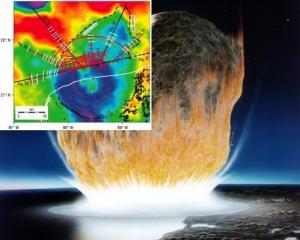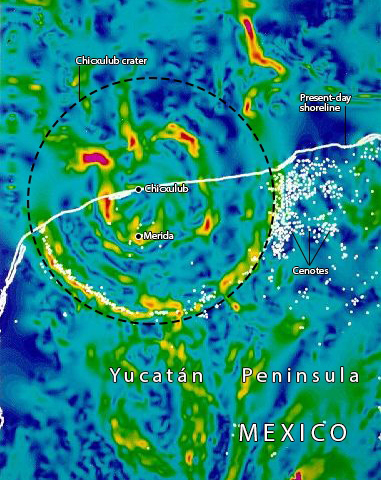Scientists Set Out to Explore Chicxulub Impact Crater
Impact Crater from Dinosaur Extinction Event to be Explored
Plans are in place for a team of international researchers to drill into the seabed off the Yucatan peninsula (Mexico), so that they can explore the composition and structure of the Chicxulub impact crater, the site where around 66 million years ago, a huge rock from space crashed into our planet. The impact was so immense that the devastation and climate change events that this collision caused may well have resulted in (or at least assisted with), the extinction of the dinosaurs.
The scientists intend to drill into the crater, which is buried under sediments over fifteen hundred metres thick and study the elevated sections called the “peak ring”. These rocks were forced up by the impact and form the boundary of the impact site, these topographically elevated rings are present in nearly all extraterrestrial impacts and the scientists hope to learn more about the Chicxulub impact itself as well as gaining a better understanding of such impact events and their effect on our our rocky planet.
Chicxulub Impact crater
An International Research Team Plan to Explore the Chicxulub Impact Crater
Picture credit: Map from Nature Geoscience / illustration courtesy of NASA
The Cretaceous mass extinction event is one of the most researched areas of science. Improving our knowledge of how the climate change affected life in the past is helping to shape current policies as our planet experiences a period of exceptional warming. Whether or not the extraterrestrial impact was the cause of the extinction of about 70% of terrestrial life, marking the end of the Age of Dinosaurs, is still debated.
Dating the Impact Event
Recent research from Glasgow University dates the impact at approximately 66,038,000 years ago +/- 11,000 years (margin of error). This date according to many scientists is about 300,000 years before the Dinosauria extinction. Whether the impact is the single cause, or whether it contributed to the mass extinction which occurred as a result of a number of factors remains when one of the hottest topics in palaeontology.
It was father and son team Luis and Walter Alvarez, who in 1980, publicised the discovery of a layer of clay with high levels of the rare Earth element iridium which mark the Cretaceous/Tertiary boundary (the K-T boundary). They argued that the iridium was deposited as a result of an impact event where a meteorite or some other rocky body crashed into our planet. The discovery of the Chicxulub crater that dated from the end of the Cretaceous provided “the smoking gun” evidence that just such an event had occurred.
The scientists involved in this new research project gathered in the city of Merida (Mexico) last week. Merida, is within the 125 mile wide impact site that marks the Chicxulub event. Scientists have estimated that the extraterrestrial object, perhaps an asteroid or even a comet, was at least six miles wide and it was travelling about eight times faster than a bullet when it hit the Earth.
Expensive Research Programme
About £6 million GBP has been set aside for funding, approved by the European Consortium of Ocean Research Drilling (ECORD). Sean Gulick, who holds many academic posts including Associate Professor at the UT Jackson School of Geosciences, is part of the research team and has spent many years studying the geology of the Yucatan peninsula. He hopes to acquire samples from the crater in a bid to learn more about the impact and its consequences.
Explaining the purpose behind the planned expedition, which is due to start next year, Sean stated:
“What are the peaks made of? What can they tell us about the fundamental processes of these impacts, which is this dominant planetary resurfacing phenomena?”
The Associate Professor and long-time co-worker, Professor Joanna Morgan (Imperial College, London) have collaborated on a number of research projects exploring the Chicxulub impact crater, to read more about their research and earlier explorations of the geology of the Yucatan peninsula, click the link below:
To read more about this earlier research by the University of Texas: Getting to the Bottom of the Chicxulub Crater.
A Geophysical Map Outlining the Impact Crater and the Crater Peaks
Picture credit: NASA
The picture above shows a colour coded geophysical gravity map of the Yucatan peninsula. The white dots represent “Cenotes”, these are sink holes which were formed as a result of the impact event.
Exploring Traces of Microscopic Life
The international research team are keen to explore the traces of microscopic life that may have lived inside the peak rocks of the crater. The geophysical maps of the region indicate that these rocks are porous and they may have acted as miniature environments for types of extremophiles to thrive in the hot, chemically enriched area surrounding the crater.
In addition, core samples should provide evidence of the earliest recovery of marine life after the extraterrestrial impact, providing scientists with an idea about how life on Earth bounces back from such cataclysmic events.
Commenting on the search for evidence of life, Associate Professor Gulick stated:
“The sediments that filled in the crater should have the record for organisms living on the sea floor and in the water that were there for the first after the mass extinction event. The hope is, we can watch life come back.”
Working from an offshore platform, the expedition is likely to last eight weeks and the cores taken will be the first to be extracted from the impact site. The first papers on the analysis of these core samples are expected at the end of next year, we at Everything Dinosaur, look forward to this analysis of the “Alvarez smoking gun”.



